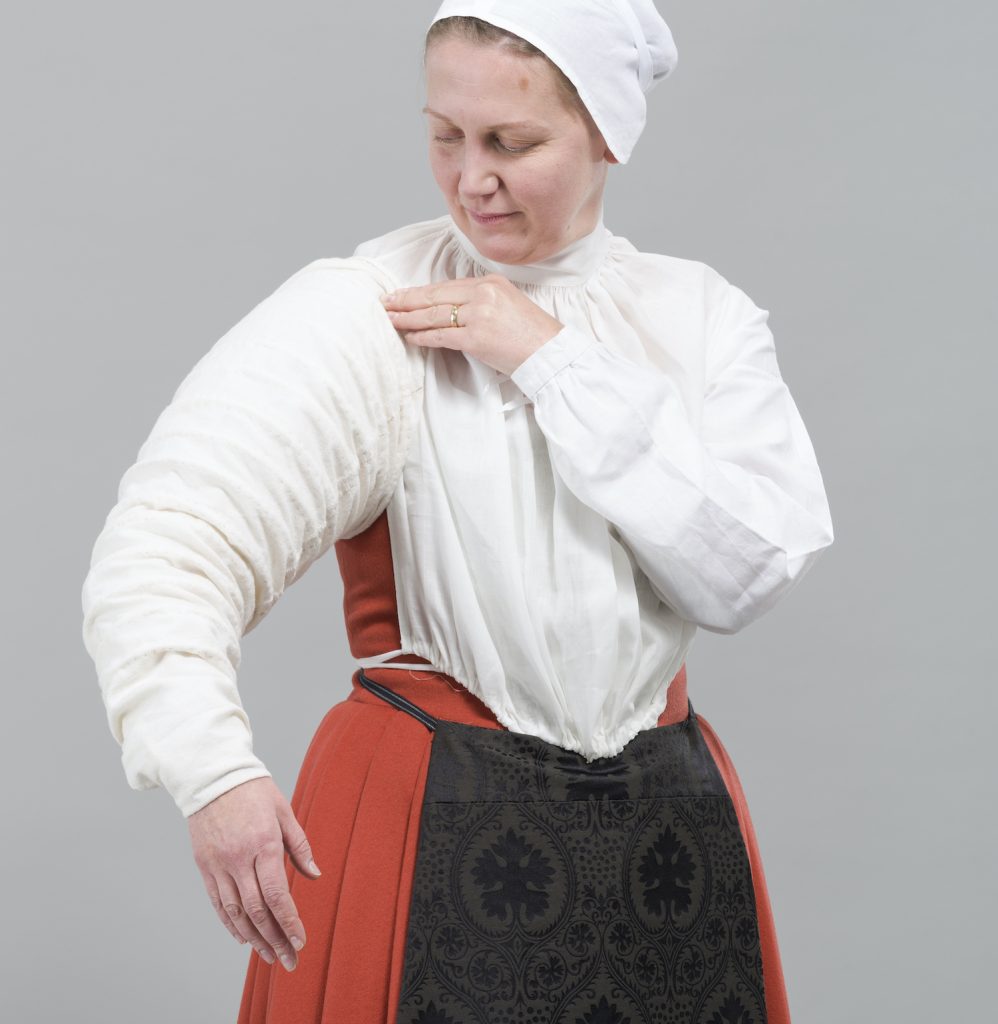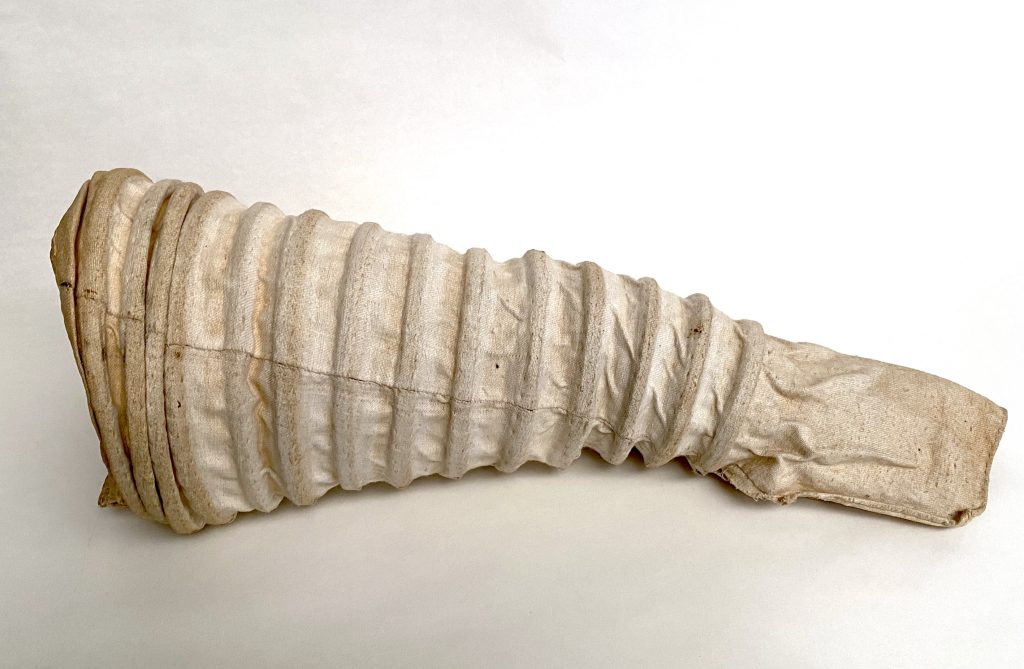
by Ninya Mikhaila
The discovery of rare, or unknown items of historic dress is always exciting. It can also be challenging when the extant object offers evidence which contradicts previously held beliefs about people in the past. A farthingale sleeve dating from the 1590s, made of fustian and sewn with fourteen whalebone hoops, is one such finding.
The late Elizabethan era was one of extreme fashion in dress, for both men and women. Narrow, elongated waists were admired, and they were accentuated on both men and women by full hips enhanced with hooped petticoats or bombasted breeches and wide shoulders held out with padding and boning.


Photo Adam Shaw; © The Tudor Tailor
The many portraits and sculpted effigies which survive from this period depict the nobility rigidly clad in layers of rich fabrics and jewels, heads held stiffly upright with large lace-trimmed and starched ruffs. These images can give the impression that the wearers were uncomfortable and restricted by their clothes, and that their movements must have been stiff and unnatural. It does not take long for younger generations to look back at those who lived before and have difficulty in relating to them.
Before the sleeve support came back to light in the first quarter of the 21st century, it was discovered by a descendant of the original owner less than a hundred years after it would have been high fashion. In 1687, the seventeen year old Cassandra Willoughby moved into Wollaton Hall in Nottinghamshire, along with her older brother Francis.
It was a grand Elizabethan residence completed by their great, great grandfather Francis Willoughby in 1588. The house had been largely deserted following a fire in 1642, but many of the contents remained, including items of clothing in a wardrobe which Casssandra supposed to have belonged to her great, great grandmother Elizabeth Willoughby née Lyttleton. She clearly found the old-fashioned styles curious and fascinating. Some of the garments she describes still exist, such as ‘several hollan head bands and quoives for the head made of fine Holland embrodred with silk, gold and spangles’ and ‘two white wrought waistcoats to be worn with petticoats, which I believe was the undress then in fashion.’
Other items described by Cassandra, such as ‘a frame of wire for the hair, which was to fix jewels in to ware upon the head’ have sadly not survived. The clothing offered an entertaining diversion for the young Willoughbys.
Cassandra writes:
‘At Christmas my brother invited all his neighbours and some of his acquaintance from London to keep the Holy days with us, when my brother diverted himself and the company in a very cheerful and innocent manner – a little play – and to make that the more comical he made an old wardrobe of short coats, ruffs, farthingales etc. to be brought out to dress some of the company in the same manner as some of the family pictures in Wollaton parlour are dressed, which helped to add to the mirth.’
Many costume historians of the 19th and 20th centuries have been similarly amused by the exaggerated and seemingly impractical fashions of the late sixteenth century. The evidence presented by the original artefact demonstrates that the enhanced proportions were achieved with surprisingly lightweight materials. The original sleeve weighs 200g (just over seven ounces) and a reconstruction, using brushed cotton fabric and modern plastic boning in place of the original fustian and whalebone, proved to be light, flexible and comfortable to wear in contrast to previously held assumptions that such large sleeves would impede movement.

Private collection; photo © The Tudor Tailor
In addition, the distinctive visual effect that the hooped support gives, when worn beneath the outer sleeve of a gown or doublet, makes it clear that the Elizabethan sculptor or artist was faithfully depicting real garments worn by real people. Though the farthingale sleeves themselves cannot be seen in these images, the striking impression they make underneath the outer garments is unmistakable. The hoops are often clearly visible through the fabric of the sleeves. These findings lend credence to the value of apparently stylised artworks as a source for evidence for early modern dress.
It has been argued that funerary sculptures were created from stock patterns, and that they bear no real resemblance to the person in life. Recent studies have illustrated that those who commissioned artists and sculptors valued realistic representation over invention.
While life-like portraits of the face are not common in effigies until the 1620s and 1630s, there is evidence that items of dress and armour belonging to the deceased were provided to the sculptors to work from and, in the case of armour, the inclusion of flaws, repairs and inconsistencies strongly suggest that they are reliable representations of actual items of dress which were not as outlandish as they may first appear.
Read the full article, Borne Out with Whalebone: A Late Sixteenth-Century Farthingale Sleeve by Ninya Mikhaila, in the latest issue of Costume.
About the journal

Costume is the journal of The Costume Society, presenting current research into historic and contemporary dress. The journal publishes articles from a broad chronological period and with a worldwide remit, maintaining a balance between practice and theory with a focus on the social significance of dress.
Sign up for TOC alerts, subscribe to Costume, recommend to your library, and learn how to submit an article.
Sign up to our mailing list to keep up to date with all of our free content and latest releases
About the author
Ninya Mikhaila is a historical costumier making high quality reconstructions for museums and heritage sites, and is one half of The Tudor Tailor, a company specialising in reconstructing, and publishing material on 16th century dress.





